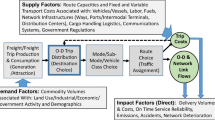Abstract
This paper reports on current freight forecasting models used inside and outside of the U.S. Our study first classifies available models into seven classes, and describes important modeling concepts and case studies applying these models. Our study summarizes primary independent variables (inputs) and outputs for these freight models in order to help understand the current status of freight forecast modeling. In addition, we found that a common characteristic of the case studies shows that freight modeling is not always done as a single project at one point in time nor do the most successful studies rely on a single class of the model. Due to resource constraints or evolving freight needs, public agencies can opt to stage their freight model development or combine and remove portions of certain classes as they see fit. Our paper concludes by discussing three types of hybrid models involving commodity supply chains, urban logistics tours, and economic tours which are considered for the future modeling trends.
Similar content being viewed by others
References
Boerkamps, J. H. K., van Binsbergen, A. J., and Bovy, P. H. L. (2000). “Modeling behavioral aspects of urban freight movement in supply chains.” Transportation Research Record: Journal of the Transportation Research Board, No. 1725, Transportation Research Board of the National Academies, Washington, D.C., pp. 17–25.
De Jong, G. and Ben-Akiva, M. (2007). “A micro-simulation model of shipment size and transport chain choice.” Transportation Research Part B, Vol. 41, No. 9, pp. 950–965.
Federal Highway Administration. Freight Analysis Framework. http://ops.fhwa.dot.gov/freight/freight_analysis/faf/index.htm Accessed March 1, 2008.
FHWA (2002). Freight analysis framework overview, Publication FHWA, FHWA-OP-03-006.
FHWA (2007). Quick response freight manual I and II, Freight Management and Operations, U.S. Department of Transportation, Federal Highway Administration, FHWA-HOP-08-010.
Fischer, M. J., Outwater, M. L., Cheng, L. L., Ahanotu, D. N., and Calix, R. (2005). “Innovative framework for modeling freight transportation in Los Angeles county, California.” Transportation Research Record: Journal of the Transportation Research Board, No. 1906, Transportation Research Board of the National Academies, Washington, D.C., pp. 105–112.
Hunt, J. D., Donnelly, R., Abraham, J. E., Batten, C., Freedman, J., and Hicks, P. J. (2001). “Costinett, and W.J. Upton. Design of a statewide land use transport interaction model for oregon.” Proceedings from World Conference on Transportation Research, Seoul, South Korea, p. 41.
Hunt, J. D. and Stefan, K. J. (2007). “Tour-based micro simulation of urban commercial movements.” Transportation Research Part B, Vol. 41, No. 9, pp. 981–1013.
Iowa Department of Transportation and Iowa State University Center for Transportation Research and Education. http://ctre.iastate.edu/Research/statemod/dev_guid.pdf Accessed April, 8, 2008.
National Cooperative Highway Research Program Report 606 (2008). Forecasting statewide freight toolkit. Transportation Research Board, Washington, D.C.
Ohio Department of Transportation. Office of Urban and Corridor Planning. http://www.dot.state.oh.us/Planning/Freight/freight_impacts_report.htm Accessed March 5, 2008.
Pennsylvania Department of Transportation. Development of the Pennsylvania Statewide Commodity-Based Freight Model (2007). 11th TRB National Transportation Planning Applications Conference.
Proussaloglou, K., Popuri, Y., Tempesta, D., and Kasturirangan, K. (2007). “Wisconsin passenger and freight statewide model: Case study in statewide model validation.” Journal of Transportation Research Record, Transportation Research Board of the National Academics, Washington D.C., No. 2003, pp. 120–129.
Tavasszy, L. A., Smeenk, B., and Ruijgrok, C. J. (1998). “A DSS for modeling logistic chains in freight transport policy analysis.” Intelligent Transportation Operational Research, Vol. 5, No. 6, pp. 447–459.
United States Government Accountability Office (2007). Freight transportation national policy and strategies can help improve freight mobility, Publication GAO, GAO-08-287.
U.S. Census Bureau. Commodity Flow Survey. http://www.census.gov/svsd/www/cfsdat/cfsoverview.htm Accessed March, 1, 2008.
Wisetjindawat, W. and Sano, K. (2003). “A behavioral modeling in micro-simulation for urban freight transportation.” Journal of the Eastern Asia Society for Transportation Studies, Vol. 5, pp. 2193–2208.
Author information
Authors and Affiliations
Corresponding author
Rights and permissions
About this article
Cite this article
Yang, C., Regan, A.C. & Son, Y.T. Another view of freight forecasting modeling trends. KSCE J Civ Eng 14, 237–242 (2010). https://doi.org/10.1007/s12205-010-0237-y
Received:
Accepted:
Published:
Issue Date:
DOI: https://doi.org/10.1007/s12205-010-0237-y




